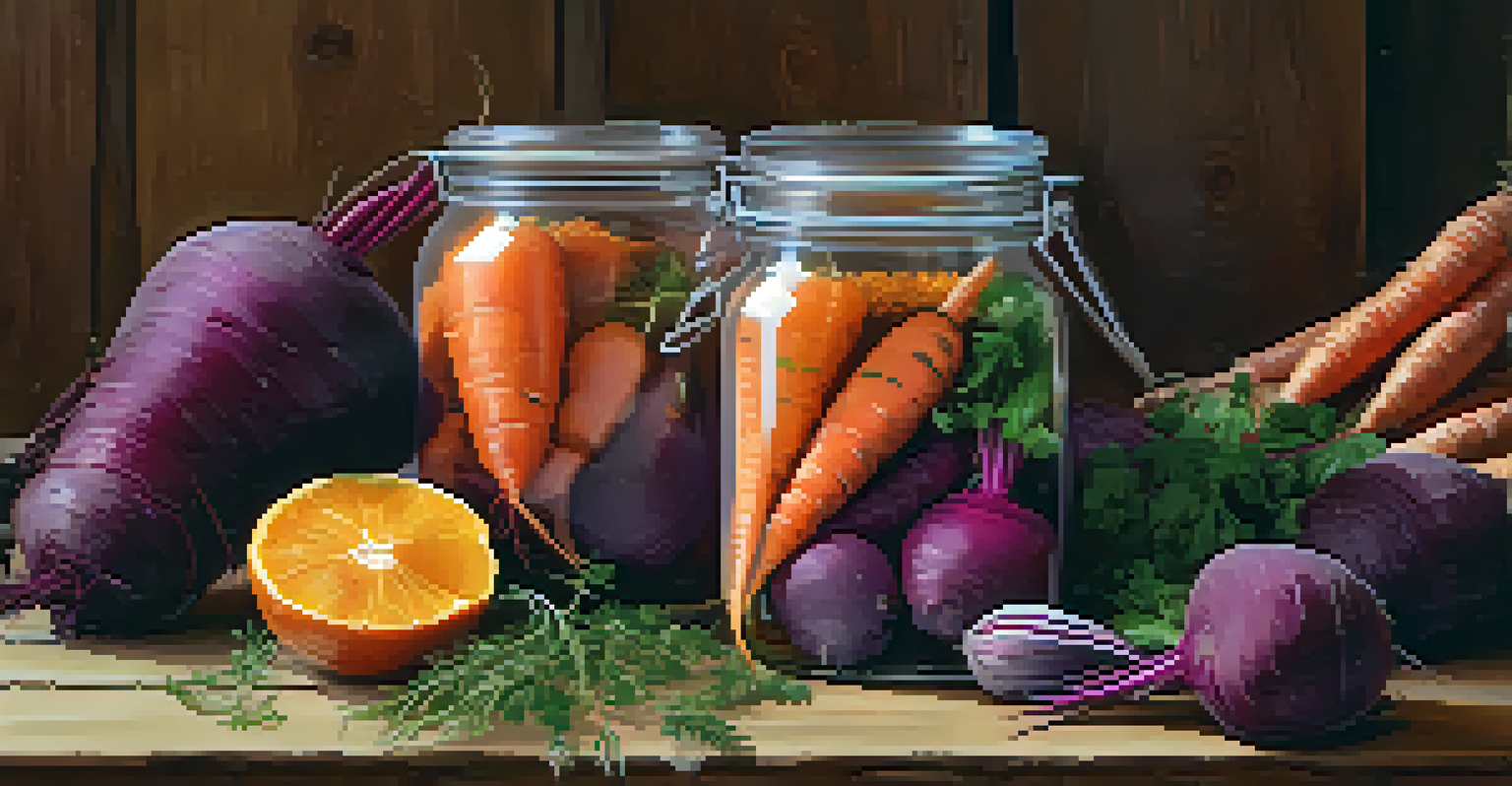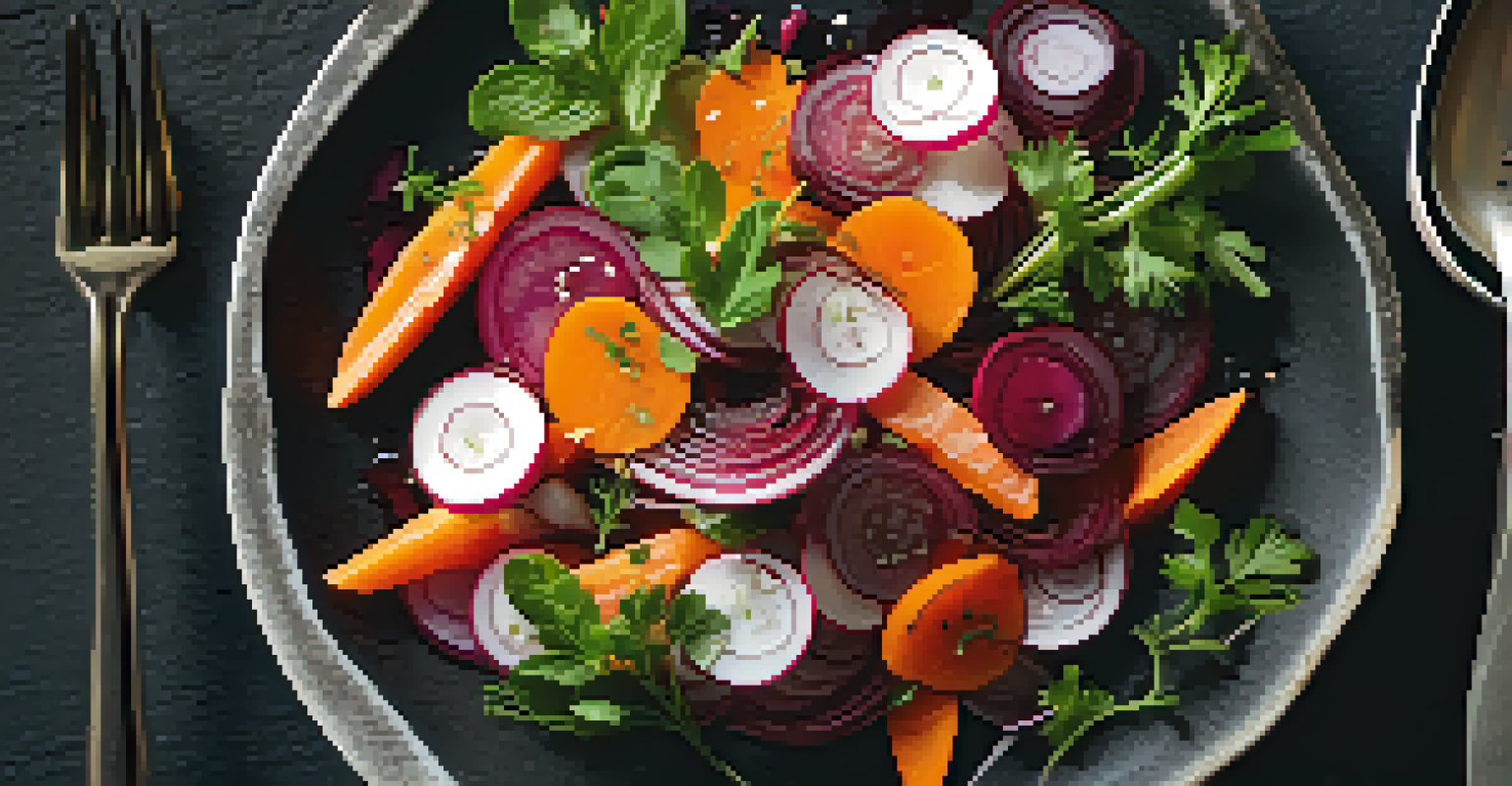Root Vegetable Fermentation: A Unique Flavor Experience

Understanding Root Vegetable Fermentation
Fermenting root vegetables is an ancient practice that transforms simple ingredients into flavorful, probiotic-rich foods. This process involves beneficial bacteria breaking down sugars and starches, creating a unique taste experience. Think of it as giving your veggies a little spa day, where they emerge rejuvenated and bursting with flavor.
Fermentation is a way of life. It is a chance to take ordinary ingredients and transform them into something extraordinary.
Common root vegetables used in fermentation include carrots, beets, and radishes. Each one brings its own distinct flavor profile and texture, making the possibilities for creativity in the kitchen endless. Fermentation not only enhances taste but also increases nutritional value, allowing you to enjoy your veggies in a whole new light.
Whether you're a novice or a seasoned fermenter, understanding the basics is essential. You don’t need elaborate equipment; just a clean jar, some salt, and your choice of root veggies. Let’s dive deeper into this flavorful journey and discover how to get started!
The Science Behind Fermentation
At its core, fermentation is a natural process that relies on microorganisms, primarily bacteria, and yeasts. When you submerge root vegetables in a salty brine, these microorganisms flourish and begin to break down the sugars present in the veggies. This not only alters the flavor but also increases shelf life, allowing you to enjoy your creations long after the harvest.

Lactic acid fermentation is the most common type used for root vegetables. During this process, lactic acid bacteria convert sugars into lactic acid, resulting in that tangy, zesty flavor we love. It’s a bit like how sourdough bread develops its characteristic taste, making every bite more exciting.
Fermentation Enhances Flavor & Nutrition
Fermenting root vegetables transforms their taste and boosts their nutritional value, offering a delicious way to enjoy your veggies.
Understanding this scientific backdrop can help you troubleshoot any issues that may arise during fermentation. For example, if your batch doesn’t taste as expected, it might be due to temperature fluctuations or the salt concentration in the brine. Knowledge is power, especially in the kitchen!
Choosing the Right Root Vegetables
Not all root vegetables are created equal when it comes to fermentation. While carrots and beets are popular choices, you can also experiment with parsnips, turnips, and even sweet potatoes. Each vegetable brings a unique texture and flavor, allowing you to create a variety of fermented delights.
Food is not just what we eat; it's how we eat, and it’s also what we do with it afterwards—like fermenting it.
When selecting your root veggies, look for fresh, firm specimens without blemishes. Organic options are often recommended as they are less likely to have pesticide residues that could affect fermentation. Remember, the fresher the ingredients, the better the end product!
You can even combine different root vegetables for a more complex flavor profile. For instance, mixing carrots with ginger can add a fresh zing to your fermented creation. Don't be afraid to get creative and tailor your ferments to your taste preferences!
Essential Equipment for Fermentation
You don’t need a lot of fancy equipment to start fermenting root vegetables. A simple glass jar, a weight to keep your veggies submerged, and a breathable cover (like cheesecloth or a cloth napkin) will do the trick. This setup allows gases to escape while preventing contaminants from entering.
If you’re serious about fermentation, consider investing in a fermentation crock or a dedicated fermentation jar with an airlock. These tools can help create the optimal environment for your veggies to thrive, allowing for consistent results. Think of them as your trusty sidekicks in the kitchen!
Simple Equipment Needed for Fermentation
You only need basic tools like a glass jar and salt to start fermenting, making it accessible for everyone.
As you get more comfortable with the process, you may find yourself wanting to experiment with different fermentation techniques, such as using a pressure cooker or experimenting with temperature control. But remember, the basics are often all you need to create delicious fermented root vegetables.
The Fermentation Process: Step-by-Step
Getting started with root vegetable fermentation is easier than you might think. Begin by cleaning and chopping your chosen vegetables into uniform pieces. This ensures even fermentation and a consistent flavor. Then, make a brine using water and salt, aiming for a ratio of about 2 tablespoons of salt per quart of water.
Once your brine is ready, add the chopped veggies to your jar, leaving some space at the top. Pour in the brine until the vegetables are fully submerged, then add a weight to keep them down. Cover the jar with your breathable cloth and secure it with a rubber band to allow airflow while keeping out unwanted pests.
Now comes the waiting game! Place your jar in a cool, dark place and let it ferment for anywhere from a few days to a few weeks, depending on your taste preference. Don’t forget to taste along the way; the beauty of fermentation is that you can decide when it’s just right for you!
Flavoring Your Fermented Root Vegetables
While root vegetables have their own delightful flavors, adding spices and herbs can elevate your fermented creations to new heights. Think garlic, dill, mustard seeds, or chili flakes—these ingredients can infuse your veggies with exciting new tastes. It's similar to how adding herbs can transform a simple soup into a gourmet dish.
Experimenting with different flavor combinations can lead to some surprising and delicious outcomes. For example, pairing beets with caraway seeds adds an earthy, aromatic twist. Don’t hesitate to try your hand at mixing flavors; the more adventurous you are, the more rewarding the results.
Experiment with Flavors in Fermentation
Adding spices and herbs to your fermented root vegetables allows for creative flavor combinations and personal recipes.
As you gain confidence in your fermentation journey, consider developing signature recipes that reflect your personal taste. This not only makes the process more enjoyable but also allows you to share your unique creations with friends and family.
Storing and Enjoying Your Fermented Veggies
Once your root vegetables have reached the desired level of fermentation, it’s time to store them properly. Transfer them to clean glass jars or containers, ensuring they remain submerged in their brine to maintain freshness. Store them in the refrigerator, where cool temperatures will slow down the fermentation process and preserve flavors.
Fermented root vegetables can be enjoyed in various ways, from adding them to salads and sandwiches to using them as a tangy topping for tacos. They can also be a fantastic addition to grain bowls, providing that much-needed crunch and zing. Think of them as the cherry on top of your culinary creations!

As you incorporate these vibrant veggies into your meals, you'll not only enhance the flavor but also provide your body with beneficial probiotics. It's a win-win situation—delicious food that also supports your gut health. So, what are you waiting for? Dive into the world of root vegetable fermentation and elevate your cooking adventures!